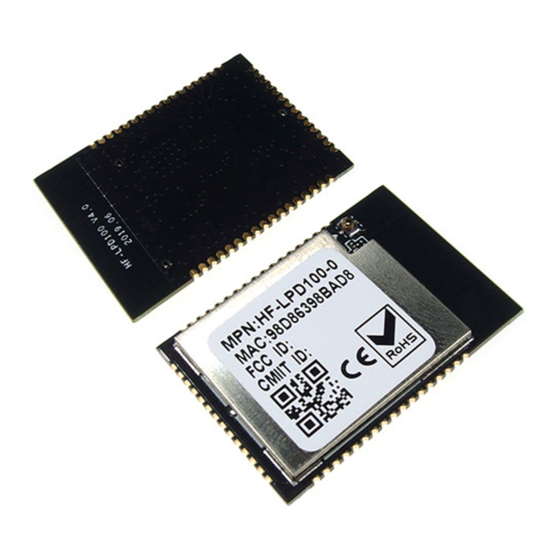High-Flying HF-LPD100 Panduan Pengguna - Halaman 16
Jelajahi secara online atau unduh pdf Panduan Pengguna untuk Router Nirkabel High-Flying HF-LPD100. High-Flying HF-LPD100 16 halaman. 802.11a/b/g/n wifi module

8. Information on test modes and additional testing requirements
a)The modular transmitter has been fully tested by the module grantee on the required
number of channels,modulation types, and modes, it should not be necessary for the host
installer to re-test all the available transmitter modes or settings. It is recommended that the
host product manufacturer, installing the modular transmitter,perform some investigative
measurements to confirm that the resulting composite system does not exceed the spurious
emissions limits or band edge limits (e.g., where a different antenna may be causing
additional emissions).
b)The testing should check for emissions that may occur due to the intermixing of emissions
with the other transmitters, digital circuitry, or due to physical properties of the host product
(enclosure). This investigation is especially important when integrating multiple modular
transmitters where the certification is based on testing each of them in a stand-alone
configuration. It is important to note that host product manufacturers should not assume that
because the modular transmitter is certified that they do not have any responsibility for final
product compliance.
c)If the investigation indicates a compliance concern the host product manufacturer is
obligated to mitigate the issue. Host products using a modular transmitter are subject to all
the applicable individual technical rules as well as to the general conditions of operation in
Sections 15.5, 15.15, and 15.29 to not cause interference. The operator of the host product
will be obligated to stop operating the device until the interference have been corrected .
9. Additional testing, Part 15 Sub part B disclaimer The final host / module combination
need to be evaluated against the FCC Part 15B criteria for unintentional radiators in order
to be properly authorized for operation as a Part 15 digital device.
The host integrator installing this module into their product must ensure that the final
composite product complies with the FCC requirements by a technical assessment or
evaluation to the FCC rules, including the transmitter operation and should refer to guidance
in KDB 996369. For host products with certified modular transmitter, the frequency range of
investigation of the composite system is specified by rule in Sections 15.33(a)(1) through
(a)(3), or the range applicable to the digital device, as shown in Section 15.33(b)(1),
whichever is the higher frequency range of investigation When testing the host product, all
the transmitters must be operating.The transmitters can be enabled by using publicly-
available drivers and turned on, so the transmitters are active. In certain conditions it might
be appropriate to use a technology-specific call box (test set) where accessory 50 devices or
drivers are not available. When testing for emissions from the unintentional radiator, the
transmitter shall be placed in the receive mode or idle mode, if possible. If receive mode only
is not possible then, the radio shall be passive (preferred) and/or active scanning. In these
cases, this would need to enable activity on the communication BUS (i.e., PCIe, SDIO, USB)
to ensure the unintentional radiator circuitry is enabled. Testing laboratories may need to add
attenuation or filters depending on the signal strength of any active beacons (if applicable)
from the enabled radio(s). See ANSI C63.4, ANSI C63.10 and ANSI C63.26 for further
general testing details.
The product under test is set into a link/association with a partnering device, as per the
normal intended use of the product. To ease testing, the product under test is set to transmit
at a high duty cycle, such as by sending a file or streaming some media content.
FCC Warning:
Any Changes or modifications not expressly approved by the party responsible for compliance
could void the user's authority to operate the equipment. This device complies with part 15 of the
FCC Rules. Operation is subject to the following two conditions: (1) This device may not cause
harmful interference, and (2) This device must accept any interference received, including
interference that may cause undesired operation
